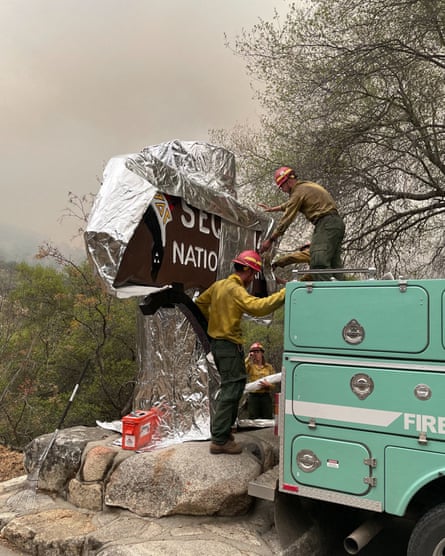As flames crept closer to California’s cherished sequoia trees firefighters took an unusual step to protect them, wrapping the giant bases in fire-resistant blankets.
The shiny material that helps quell flames, commonly used to protect structures, is rarely applied to natural features, but crews fighting the KNP Complex fire in the Sequoia national park said they are doing everything possible to protect the iconic trees.
“It is really indicative of what a special priority the iconic monarch sequoias of the Giant Forest are for the parks and for the incident management team,” said fire spokesperson Rebecca Paterson.
The KNP Complex fire – which consists of two lightning-sparked blazes burning together – forced the evacuation of the park this week, and parts of the town of Three Rivers outside the main entrance remained evacuated Thursday. The wildfires are among the latest in a long summer of blazes that have scorched nearly 9,195 sq km in California, destroying hundreds of homes.
By Friday morning, the KNP Complex fire had grown to more than 11,300 acres, and was within a mile of the famed Giant Forest. The General Sherman tree was among the sequoias that were wrapped, along with the Giant Forest museum and other buildings, Paterson said.
The General Sherman tree is the largest in the world by volume, at 1,487 cubic meters, according to the National Park Service. It towers 84 meters high and has a circumference of 31 meters at ground level.
The wrapping was applied only to the base of the tall trees that stretch hundreds of feet into the sky. “It is just being applied by firefighters on the ground so it is not possible to put it 100 feet up or anything,” Paterson said. “The idea is to keep ground fire from getting at the tree where it is most likely to burn, which is close to the ground.”

The aluminium wrapping can withstand intensive heat for short periods. Federal officials say they have been using the material for several years throughout the US west to protect sensitive structures from flames. Homes near Lake Tahoe that were wrapped in protective material survived while others nearby were destroyed.
The Colony fire, one of two burning in Sequoia national park, had grown toward the Giant Forest, a grove of 2,000 sequoias, but firefighters have so far been able to keep the blaze out of the grove. Paterson said conditions on the ground are aiding in the firefight and that officials are hopeful the trees will stay safe.
“The good news is that, today in particular, fire behavior has been fairly moderate so we are not seeing a lot of canopy fire or great, big dramatic runs in the fire,” she said Friday morning. “It has been a fairly slow, backing, creeping spread.”
Giant sequoias are adapted to fire, which can help them thrive by releasing seeds from their cones and creating clearings that allow young sequoias to grow. But the extraordinary intensity of fires – fueled by climate change – can overwhelm the trees. That happened last year when the Castle fire killed 7,500 to 10,600 large sequoias, according to the National Park Service.
A historic drought and heat waves tied to climate change have made wildfires harder to fight in the American west. Scientists say climate change has made the region much warmer and drier in the past 30 years and will continue to make weather more extreme and wildfires more frequent and destructive.
But a 50-year history of using prescribed burns – fires set on purpose to remove smaller trees and vegetation that would otherwise feed wildfires – in the parks’ sequoia groves was expected to help the giant trees survive by lessening the impact if flames reach them.
Close to 500 firefighters are battling the blaze, which is burning in steep, rugged terrain that’s difficult to access. More are on the way. Officials are still hopeful they can keep the fire from entering the grove. Even if it does get in, the trees are now in a good position to weather the flames.
“That kind of fire behavior is often not problematic in sequoia groves,” Paterson said. “There is a lot of reason for optimism that even if fire gets into some of those areas it will not be devastating.”